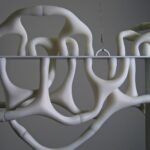This week’s theme immediately got me thinking about my own discipline of geography. During my degree the impact of human induced marine plastic waste on our oceans has been recurring topic. When I think of ‘plastic pollution’, the images that instantly come to mind are examples such as the Great Pacific Garbage Patch or the layers of thousands of washed-up plastic objects on our coastlines. All of which eventually breakdown into indigestible and toxic microplastics which are responsible for the death of hundreds of thousands of marine animals, plants and algal species and the destruction of aquatic ecosystems (Chatterjee and Sharma, 2019).


‘This Will Kill That’, microplastic covered pedestrian barrier, by Simon Anton, La Biennale di Venezia, 2023, photographed by Katy Knapp
We have an extreme and normalised dependency on plastics, and for many of us, the long-term consequences and impact of this obsession go unrecognised. This plastic pollution issue is especially linked to our unsustainable tourism and travel behaviours (Dube and Nhamo, 2021). While in recent years many of us have made changes to our personal home use of plastic, opting for tote bags when shopping for example, or using refillable water bottles, studies have shown that when we travel our plastic purchasing and usage is significantly higher (One planet network, 2023). Around 80% of tourism occurs in coastal regions, thus unsurprisingly this is one of the largest drivers of plastic pollution globally (One planet network, 2023). Single use plastic bottles are a huge contributor to this problem, whether this is because of a fear of consuming local water or drinks, or the convenience of using small plastic travel containers and toiletries, tourism and travel have encouraged too many of us to continue to consume and produce plastic waste at an alarming rate.
When it came to producing a final outcome for this week’s workshop, I wanted to redesign a travel item that I would use when travelling. I immediately thought of my foldable Spanish fan that I have travelled with for more than 10 years. I wanted to see if I could recreate my foldable fan out of a plastic bottle that I had used when travelling.

I expected the cutting, piercing, and assembling of the plastic bottle into a fan to be a relatively simple task. However, I had overestimated the material’s strength and durability. It remedied me of Bennet’s (2009) notion of vital materialism from lasts weeks debate, where the vitality of the plastic became immediately obvious when I was forced to engage with it in a way I had not done before. The plastic was difficult to penetrate with a blade at first and pining the fan pleats together was a fiddly task, as I was met with resistance! The materials ‘vibrancy’ cannot be overstated, and while it took several attempts to assemble, the plastic became easier to work with once I coped with its strength and I hammered the pin in place. Despite the initial difficulty, on assembling my fan I appreciated how adaptable plastics can in fact be. My new fan was completely operable, I enjoyed the aesthetic of it and I could see myself using it frequently when travelling. This exercise made me re-think the achievability of up-cycling other objects I own and remodeling them in used plastic. On a larger or more commercial scale I could see how redesigning and reusing in this way could be effective in reducing our already mounting plastic pollution problem.
Final Outcome: Plastic foldable fan, Katy Knapp, 2023


After completing my plastic bottle redesign, I was thrilled to find some plastic bottle redesigning in action on the streets of Venice, as souvenir flower gifts. This demonstrated that the material vitality of plastics are being acknowledged in some form as ‘lively matter’ by artists, and that my simple homemade redesign can actually be successful in other contexts too.


Used Plastic Bottle Flowers, Venice, 2023, photographed by Katy Knapp
References:
Bennett, J., 2009. Vibrant matter: A political ecology of things. Duke University Press.
Chatterjee, S. and Sharma, S., 2019. Microplastics in our oceans and marine health. Field Actions Science Reports. The Journal of Field Actions, (Special Issue 19), pp.54-61.
Dube, K. and Nhamo, G., 2021. Sustainable development goals localisation in the tourism sector: Lessons from Grootbos private nature reserve, South Africa. GeoJournal, 86, pp.2191-2208.
Tourism Plastic Pollution Problem (2023) One Planet Network. Available at: https://www.oneplanetnetwork.org/programmes/sustainable-tourism/global-tourism-plastics-initiative/tourisms-plastic-pollution-problem







